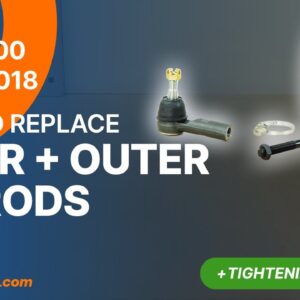Watch this video to learn how to replace the inner and outer tie rods on a 2009-2018 Dodge RAM 1500.
Replacing Inner and Outer Tie Rods on a 2009-2018 Dodge RAM 1500: What You Need
Ready to perform this DIY replacement job? Remember that all the parts in this guide can be found on CarParts.com. Check out all the products that fit your vehicle right here.
Parts Checklist
- Outer tie rods
- Penetrating oil
- Silicone grease
Tightening Torques
- Tie rod end adjuster clamp bolts: 45 Ft-lbs
- Tie rod end holding nut: 78 Ft-lbs
Tools Checklist
Here’s the toolbox we recommend to repair your Dodge RAM 1500: HM85 85 Piece Ratchet and Socket Set
List of tools:
- Hydraulic jack
- Jack stands
- Wheel lug wrench
- Marker
- 24mm wrench
- 23mm wrench
- Wire brush
- Ratchet
- 21mm socket
- 13/32” socket
- Ball joint puller
- Hammer
- Caliper
- Flat head screwdriver
- Adjustable wrench
- Torque wrench
Step-by-Step Instructions
Step 1: Turn off your engine and set the parking brake.
Step 2: Loosen the stud bolts on the front wheels.
Step 3: Lift the front of your vehicle using a suitable jack. Refer to the video on “How to jack your RAM 1500 safely” for guidance.
Step 4: Place the vehicle on the jack stands.
Step 5: To change the tie rod ends, remove the wheels for complete access to the steering system.
Step 6: Place the wheels under the vehicle.
Step 7: Turn the disc outwards to facilitate the next steps.
Step 8: Locate the outer tie rod.
Step 9: Use a marker to trace a line between the inner and outer tie rod for later reference.
Step 10: With a 24mm wrench, loosen the locknut on the outer tie rod while holding the inner tie rod with a 23mm wrench. The locknut prevents rotation of the two parts and affects wheel alignment.
Step 11: Seized components may need brushing and penetrating oil for easier removal.
Step 12: Use a socket wrench and a 21mm socket to unscrew the outer tie rod holding nut.
Step 13: If the ball joint turns, use a ratchet and a 13/32” socket to block rotation. If you don’t have a ball joint puller, hit the knuckle with a hammer to release the ball joint.
Step 14:Unscrew the outer tie rod and remove it.
Step 15: Return the locknut to its original position using the markings made with the marker.
Step 16: Measure the distance between the locknut and the end of the inner tie rod with a caliper. A professional wheel alignment check is necessary after this operation.
Step 17: Remove the locknut from the inner tie rod.
Step 18: Take the new outer tie rod and unscrew the supplied locknut.
Step 19: Screw the locknut back until the measured distance with the caliper is reached.
Step 20: Put the outer tie rod back in place until it touches the locknut.
Step 21: Work on the steering system, and a professional alignment check is recommended.
Step 22: Use an adjustable wrench to rotate the inner tie rod, placing the outer tie rod correctly.
Step 23: Scrub the knuckle with a wire brush and apply silicone grease to the flat part in contact with the outer tie rod sleeve. Do not grease the inside of the cone.
Step 24: Put the outer tie rod back in place in the knuckle.
Step 25: Put the castellated nut supplied with the new part in place and tighten it using a ratchet and 21mm socket.
Step 26: Finish tightening with a torque wrench.
Step 27: Insert the key into the castle nut and bend it with a screwdriver.
Step 28: Finish tightening the locknut using a 24mm wrench while holding the inner tie rod still with an adjustable wrench.
Step 29: Put the wheels back on your vehicle.
Step 30: Lower the car to the ground and properly block the wheels.
Step 31: The operation is now complete.
Compatible Vehicles
The operation and tools displayed in the video should be available on the following vehicles:
- 2009 Dodge Ram 1500
- 2010 Dodge Ram 1500
- 2011 Ram 1500
- 2012 Ram 1500
- 2013 Ram 1500
- 2014 Ram 1500
- 2015 Ram 1500
- 2016 Ram 1500
- 2017 Ram 1500
- 2018 Ram 1500
Important Reminders
- During this operation, you will work on the steering system of your vehicle. A professional alignment check should be performed to ensure that your steering system is once again perfectly adjusted and functioning.
- The components to be removed are very often seized up, so don’t hesitate to brush and to use penetrating oil to make removal easier.
Disclaimer:
This video is for entertainment purposes only. CarParts.com, Inc. disclaims all damages including, but not limited to, actual, consequential, and/or punitive, for any liability, claim, or any other injury or cause related to or arising from any information or lack thereof posted in this video. No information contained in this video shall create any expressed or implied warranty or guarantee of any particular result. All mechanical car projects entail some risk. It is the sole responsibility of the viewer to assume this risk. If you are in doubt, please consult a licensed mechanic in your area.
Any information provided on this Website is for informational purposes only and is not intended to replace consultation with a professional mechanic. The accuracy and timeliness of the information may change from the time of publication.















